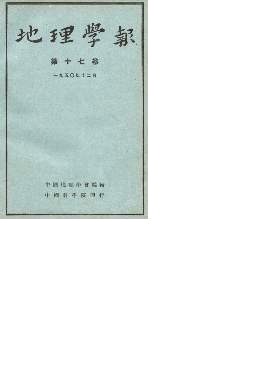Y. C. Shen
The Hengshan, one of the five sacred mountains in China, is situated in the central part of Hunan province. It is a huge granite intrusion, forming a mountain mass about 40 km. long and 17 km. wide with the highest peak rising to 1266 m. above the sealevel or more than 1000 m. above the Hsiankiang lowland. The Yenshan movement (Jurassic-cretaceous) is the greatest orogenic move-ment of Hunan. The Hengshan granite may be intruded during this movement, and a .large mountain was formed. This mountain was afterwards denuded in to a peneplain and sank somewhat down, forming a large lake, in which the Red beds of early Tertiary was deposited. During the Hengyan movement, Cate Tertiary) a great fault occurred in the Hengshan granite, and a new Hengshan was built up on the foundation of the old one. From geomorphic point of view, the Hengshan may be divided into two different parts, i. e. the eastern part or the fore mountain and the western part or the back mountain. On the eastern slope, we find a large fault, trending from NNE to SSW, forming a conspicuous fault scarp well represented by almost perpendicular triangular facets about 100 to 300 m. high. Consequent streams flowing down the fault scarp have deep and narrow V shaped gullies; where denudation is more advanced, these gullies assume fan-shaped form. Many hanging valleys and waterfalls also testify the existence of the fault scarp. On the western side of the Hengshan, a total different landform is seen. Here, the granite intrusion is overlaid by sedimentary rocks giving rise to successive hogbacks and cuestas, with subsequent valleys between them. The relative relief of these hills is about 100 m. The farther we go from the Hengshan, the smaller becomes the dip of the sedimentary strata, which gradually become horizontal, forming mesas about 30一40 m. high. The drainage pattern is essentially radial with numerous parallel consequent streams flowing down the granite dome. But subsequent streams, developed later along the fault or in the less resistant formations, capture the initial consequents which therefore become integrated into a few large streams. As the subsequents generally Aow along the rims of the dome, the drainage is gradually being changed into annular pattern. The divide between the Fore-mountain and the Back-mountain runs north- north-east to south-south-west. It resaches an altitude of about 1000 meters with Tsu-Yung-Fung (1266 m.) as a center. Owing to steeper gradient of consequents on the eastern side, the divide is being gradually shifted to the west. Four erosion surfaces have been distinguished in the Hengshan area, at 1000, 700-800, 300-400, and 150 m. above the sealevel. The highest, or 1000 m. surface, represented by summit of high peaks, is probably a fossil peneplain laid bare by stripping off its cover of Tertiary Red Beds. Remnants of the 700-800 m. surface are shown by many bread flats amid the mountains such as Li-Fu-Chung, Tan-Chia-Chung, etc, the so-called "chung" being flat surface in mountainous region. They may be correlated with bruad intermontane valleys at about the same elevation in the Chung River drainage area. The 300-400 m. surface is found in the lower part of the Hengshan where it bevels rocks ranging from Silurian and Ordovician quartzite to the Hengshan granite. The 150 m. surface is extensively developed一in Hunan; near the Hsiankiang, it is strongly dissected by later erosion.
